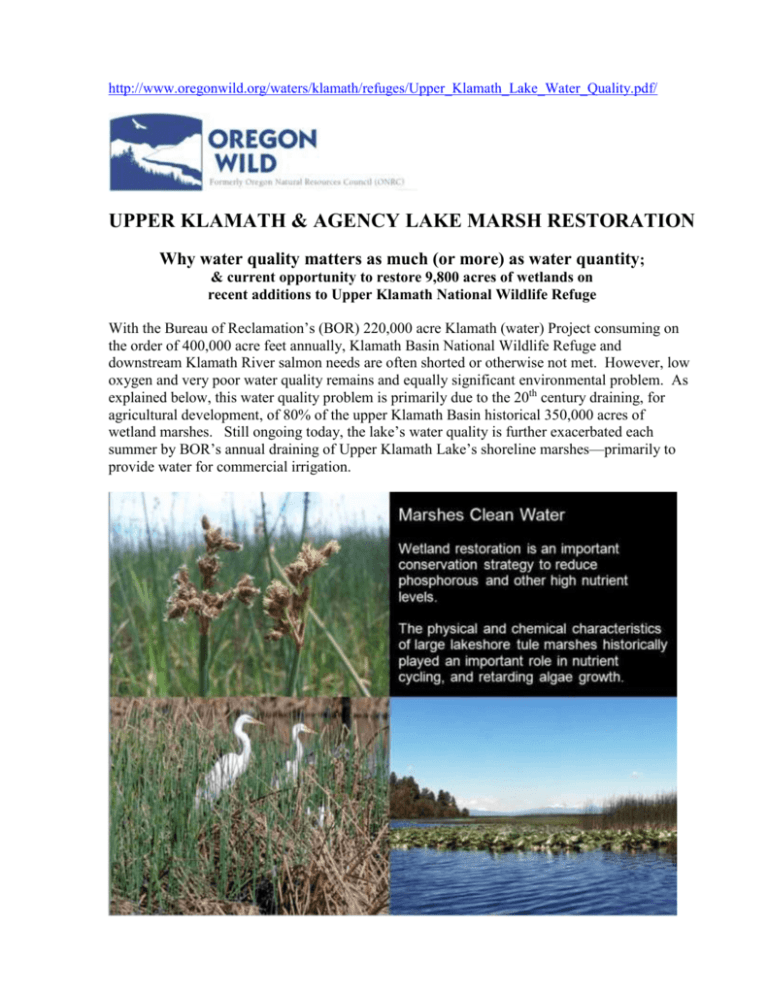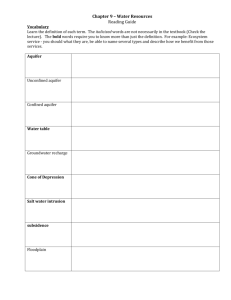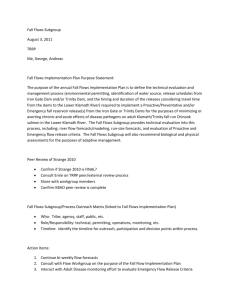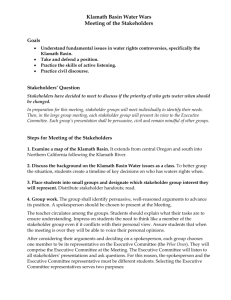Upper Klamath and Agency Lake Restoration
advertisement

http://www.oregonwild.org/waters/klamath/refuges/Upper_Klamath_Lake_Water_Quality.pdf/ UPPER KLAMATH & AGENCY LAKE MARSH RESTORATION Why water quality matters as much (or more) as water quantity; & current opportunity to restore 9,800 acres of wetlands on recent additions to Upper Klamath National Wildlife Refuge With the Bureau of Reclamation’s (BOR) 220,000 acre Klamath (water) Project consuming on the order of 400,000 acre feet annually, Klamath Basin National Wildlife Refuge and downstream Klamath River salmon needs are often shorted or otherwise not met. However, low oxygen and very poor water quality remains and equally significant environmental problem. As explained below, this water quality problem is primarily due to the 20th century draining, for agricultural development, of 80% of the upper Klamath Basin historical 350,000 acres of wetland marshes. Still ongoing today, the lake’s water quality is further exacerbated each summer by BOR’s annual draining of Upper Klamath Lake’s shoreline marshes—primarily to provide water for commercial irrigation. Page 2 Tule marshes (above), once dominated, naturally cleaning the Klamath Basin’s lakes & rivers. Basically stated, marshes clean water. This is because the principal emergent marsh vegetation (known as tule or hard-stemmed bulrush) takes ups nutrients that are incorporated into the plants roots, forming ever increasing peat soils below. Each previous year’s growth of tules, cattails and other marsh plants is annually replaced by new growth, but with the prior generation’s carbon and other nutrients being largely retained--and with little oxygen available for rapid decomposition, being built up and as the major component of the underwater, organic marsh soils. Thus, rather than causing water pollution by being lost annually when marsh muds are exposed to the open air, in a healthy functioning marsh ecosystem, most of these otherwise “free nutrients” are increasingly retained. Most importantly, water pollution is reversed as nutrients are no longer released directly into the lake only to next be washed on downstream and into the Klamath River—impacting water quality for another 240+ river miles to the Pacific Ocean. Productive marshes do, however, need to periodically fluctuate--as some significant nutrient release every decade stimulates overall marsh (and fish and wildlife) productivity. But with high irrigation water demands in the Klamath Basin’s otherwise high desert climate, marsh (and lake) water levels are fluctuated well in excess of natural, periodic fluctuations. What else is lost when marshes are drained When marshes are diked and/or regularly drained, the original marsh peat and organic soils (formed over past millennia) are instead fully exposed to oxygen in the air. This reverses their accumulation, and instead rapidly speeds their break down through chemical oxidation—in particular, releasing large quantities of polluting phosphorous and nitrogen into lake and river environments. This accelerated nutrient release significantly stimulates algae growth, ultimately increases the pH and toxic ammonia levels, and depletes the water of oxygen. The immediate and end result in the annual killing fish as well as innumerable invertebrates, amphibians, and other aquatic organisms. While best recycling nutrients, Upper Klamath Lake’s lakeshore and other upstream tule marshes additionally release algae-inhibiting tannins (humic acid). With the vast reduction in the upper basin’s historical marshes this positive, blue green algae (cyanobacteria) inhibiting effect no longer occurs in sufficient amounts to suppress the annual blue green algae blooms that seasonally flourishes, and diminishes Upper Klamath Lake’s water quality each and every summer. Genuine marsh restoration, that has been successfully occurring (primarily since 2006) at the Bureau of Land Management’s Wood River Wetlands (on Agency Lake west of Chiloquin, OR), http://www.blm.gov/or/resources/recreation/site_info.php?siteid=101 is essential to the restoration of the Klamath Basin and recovery of its endangered salmon, sucker fish as well as the enhancement of numerous birds and its many other wetland associated wildlife species. Wetland restoration projects that only re-flood former lake bed, but do not fully restore historical tule marshes are important, but of lesser ecological benefit, particularly as BOR regularly draws down lake levels, to accommodate commercial agriculture needs. This annual, and often Page 3 Just around Upper Klamath Lake alone, approximately 70 percent of the original 50,400 acres of wetlands surrounding the lake were diked, drained or significantly altered between 1889 and 1971. Page 4 excessive draw down of Upper Klamath Lake’s marshes (below an elevation of 4139 feet) leaves ALL of the lake’s remaining shoreline tule marsh wetlands dry and exposed to the effects of oxidation and erosion—further exacerbating poor water quality conditions in Agency and Upper Klamath Lakes (Oregon’s largest freshwater lake). Additionally, fish and wildlife are denied their most essential habitats. Furthermore, over the decades, lakeshore marshes that have been diked and drained, have now dropped several feet below their original elevation, thus leaving these agriculture managed lands below the elevation of the present lakeshore. This resulting “subsidence” is due to the combination of decades of soil compaction from cattle hoofs and farm machinery, as well as the rapid chemical oxidation loss of the original, surface organic marsh soils that were initially, and gradually, created over countless centuries. Sholawater Bay and ALL of Upper Klamath Lake’s remaining tule marshes are left exposed to the air, and left dry, when BOR draws the lake down below an elevation of 4139 feet. (Oregon Wild photo) Restoring the Marshes In order to reestablish ecologically functional marshes around Upper Klamath Lake, this subsidence must be reversed before the existing dikes can be breached or removed. Otherwise, just re-flooding these agriculturally managed, former marsh lands will only result in the creation Page 5 of a re-expanded lake, but without the emergent marsh vegetation of tules, bur-reeds, yellow water lilies, cattails and other aquatic plants. Thus, while removing dikes and reflooding will increase the lake’s overall size, due to subsidence, these “newly restored wetlands” can otherwise be too deep to now enable watercleansing marsh plants to significantly reestablish and grow. Thus, existing dikes must be initially retained, while water is consistently allowed to flow in and maintained at the proper, shallower depths in which aquatic plants can best reestablish and thrive. While dike removal is still the ultimate restoration goal, only when the marsh is fully re-established, and previously years of subsidence is significantly reversed, can existing dikes be notched or removed without impairing the marsh’s ecological and continued natural water cleansing functions. Wood River Wetlands—the Klamath Basin’s greatest marsh restoration success Despite the fact that over the last two decades tens of millions of dollars have been spent annually in the upper Klamath Basin to monitor, study and enhance endangered fish species habitat, only BLM’s 2,900 acre Wood River Wetlands has been specifically designed and managed to successfully meet Page 6 the goals of significant water quality improvement, wetland restoration. (See “before & after” photos below, page 9). For this, BLM is to be heartily congratulated, and the Klamath Basin NWRs should now be strongly encouraged to similarly manage the adjacent 9,800 acre BarnesAgency wetlands--that have recently been added to the Service’s Upper Klamath NWR. From 1993 until recently BOR has managed the formerly private owned Agency Lake Ranch’s mid20th century, diked cattle pastures exclusively for water storage for commercial agriculture. Termed “pump storage” water was stored within the diked compound, and then completely pumped off near the beginning of the growing season. As the refuge is now developing a management plan for these wetlands that have been transferred to it by BOR, it is important that the extensive Agency-Barnes area, on Agency’s Lakes north-west shore be managed primarily for the improvement of water quality. No other set of lands is similarly available, or so suitably geographically situated for purposes of wetland restoration and water quality enhancement. BOR’s slightly more technical discussion of Upper Klamath Lake’s water quality challenges The following are excerpts from the Klamath Falls Bureau of Reclamation’s (BOR) December 2012 Biological Assessment http://www.usbr.gov/mp/kbao/operations_planning.html that more specifically explains the biological and chemical process (just described above). Similar explanations of Upper Klamath Lakes water quality problems have been similarly published in prior US Fish and Wildlife Service (USFWS) Biological Opinions, and as demonstrate in previous studies as cited by the BOR below contained in the scientific literature). Poor water quality in Upper Klamath Lake (UKL) is particularly associated with high abundance of the cyanobacteria (or “blue green algae”) Aphanizomenon flos-aquae (AFA); Buchanan et al. 2011. Core samples of bottom sediments indicate that AFA was not present in UKL prior to the 1900s (Eilers et al. 2004, Bradbury et al. 2004). Its appearance is believed to be associated with increases in productivity of the lake (NRC 2004). AFA now dominates the phytoplankton community from June to November, and because of the high concentrations of nutrients available, is able to reach seasonally high biomass levels that lead to highly degraded water quality (ODEQ 2002). These robust algal cycles affect endangered Lost River and shortnose suckers (and other fish) as rapid algal decay depletes dissolved oxygen (DO) in the lake and creates anoxic (an extreme form of hypoxia or "low oxygen") conditions (Perkins et al. 2000b, ODEQ 2002, IMST 2003, NRC 2004, Wood et al. 2006). Such events can have lethal impacts to individual suckers (Perkins et al. 2000b) and can reduce the reproductive capacity of the populations by reducing the numbers of larger and more fecund females (Buchanan et al. 2011). Adverse water quality may also affect young suckers, but information is lacking regarding such effects (Buchanan et al. 2011). It has been suggested that large-scale watershed development from the late-1800s through the 1900s has contributed to the current hypereutrophic condition in UKL (Bortleson and Fretwell 1993, Eilers et al. 2001, Bradbury et al. 2004, Eilers et al. 2004, Geiger et al. 2005). Accelerated sediment and nutrient loading to UKL consistent with land use practices in the Upper Klamath watershed (Eilers et al. 2004) have resulted in algae blooms of higher magnitude and longer duration (Kann 1998). These blooms have led to extreme water quality conditions (high pH, low DO, and high ammonia) that increase fish stress, negatively impact fish health and increase the size and frequency of fish die-offs (Perkins et al. 2000b, Wood et al. 2006, Kuwabara et al. 2007, Morace 2007). In recent decades, the lake has experienced serious water quality problems that Page 7 have resulted in massive fish die-offs, as well as re-distribution of fish in response to changes in water quality (Buettner and Scoppettone 1990, Banish et al. 2007, 2009). UKL waters contain only moderate levels of dissolved solids and alkalinity, but high concentrations of phosphorus, which in the warm, sunny conditions of the lake during summer support high production of phytoplankton, and especially of the nitrogen fixing cyanobacteria, AFA (Buchanan et al. 2011). The growth, senescence, and decay of massive amounts of the organism result in high pH and ammonia and low DO concentrations. Water quality in UKL is adequate for fish rearing during October through mid-June, but is poor from mid-June through September (Buchanan et al. 2011). The massive blooms of AFA and the subsequent rapid decline (crash) can cause extremes in water quality including Page 8 elevated pH, low DO concentrations (hypoxia), and elevated levels of un-ionized ammonia, which can be toxic to fish (Kann and Smith 1993, Kann and Smith 1999, Perkins et al. 2000b, Walker 2001, Welch and Burke 2001, Wood et al. 2006, Kuwabara et al. 2007, Morace 2007). In the process of rapid growth, algal biomass can form extremely dense blooms, which can vary in magnitude depending on the availability of growth-promoting conditions (Kann and Smith 1993, Kann and Smith 1999, Perkins et al. 2000b). During the same bloom conditions and following a bloom crash, particularly when coupled with high rates of nighttime respiration, DO can drop to levels that restrict fish growth and that can be lethal (Kann and Smith 1993, Kann and Smith 1999, Perkins et al. 2000b). In addition, when dense algae blooms die off, the microbiological decomposition of the algae and organic matter in the bed sediment can further deplete DO and produce increased concentrations of ammonia (Kann and Smith 1993, Risley and Laenen 1999, Kann and Smith 1999, Perkins et al. 2000b, Walker 2001, Welch and Burke 2001, Wood et al. 2006, Kuwabara et al. 2007, Morace 2007). The potential for low DO concentration increases later in the growing season (July to September) when the algae blooms have crashed and considerable organic matter has accumulated in the sediments. During this same period, higher water temperature increases water column oxygen depletion rates as decomposition and respiration take place at a faster rate, while available oxygen tends to be lower because the oxygen concentration at saturation decreases as water temperature increases (Reclamation 2007). Water quality conditions in UKL are mostly attributed to nutrient loading (Buchanan et al. 2011). The lake was highly productive or “eutrophic” prior to settlement by Europeans in the mid-19th century, but it has become “hypereutrophic” from loading attributed to external (i.e., pumping of diked wetlands, agricultural runoff, timber harvest, and road development) and internal sources (i.e., lake sediments) (Snyder and Morace 1997, ODEQ 2002, IMST 2003, Bradbury et al. 2004, Eilers et al. 2004, NRC 2004). Phosphorus is the primary nutrient responsible for this hypereutrophic condition in combination with large blooms of the nitrogen-fixing algae, AFA. Phosphorus is borne by and stored in sediments (ODEQ 2002, Graham et al. 2005). Sediment accumulation rates dramatically increased during the 20th century, and these “modern” sediments are higher in nitrogen and phosphorus than during pre-settlement (Eilers et al. 2001). Dissolved phosphorous concentrations have repeatedly been implicated in favoring the growth of algae in the lake (Buchanan et al. 2011). Geologically controlled background inputs of dissolved inorganic phosphorous are high enough to have supported frequent algal blooms, but at lower concentrations than those observed in the past half-century (NRC 2004). Current average concentrations entering the lake are two-thirds higher than background (Buchanan et al. 2011). In the lake, concentrations of phosphorous peak in mid-summer at about six times background level (NRC 2004), probably as a result of phosphorous recruitment from pore waters of sediments on the lake bed. High concentrations of algae and intermittent stratification of the warm lake waters eventually cause algal death and depletion of DO (NRC 2004). Wetlands may affect water quality through production and release of decomposition products, particularly dissolved humic substances that appear to inhibit AFA growth (Geiger et al. 2005). The absence or reduction of this algae species within marsh environments has been noted at Hanks Marsh (Forbes et al. 1998) and Upper Klamath NWR (Sartoris and Sisneros 1993 cited by Campbell 1993). Perdue et al. (1981) noted Page 9 the absence of AFA in UKL at a location heavily influenced by the Williamson River, which transports water originating from the Klamath Marsh. Although the exact mechanisms are not well understood, the relationship between humate content from shoreline wetlands and inhibition of many planktonic algae species has been established on both a local and national level (Phinney et al. 1959, Perdue et al. 1981, Forbes et al. (Specific geographic location shown on page 3 map above) BLM Photos Page 10 1998, Geiger et al. 2005). It’s likely that the physical and chemical characteristics of large lakeshore marshes around UKL historically played an important role in nutrient cycling, regulating the algal community, and other characteristics of the system (Reclamation 2007). Littoral wetlands in UKL have been drastically reduced in size due to agricultural reclamation (Reclamation 2007). In 2002, Oregon Department of Environmental Quality (ODEQ) established a total maximum daily load (TMDL) for UKL. This TMDL targets the reduction of phosphorus as a means to reduce AFA production and improve water quality conditions. Although nitrogen is also an important nutrient for structuring algae communities and determining algal productivity, AFA is able to fix atmospheric nitrogen to meet its nitrogen needs in what may otherwise be a nitrogen-limiting environment (ODEQ 2002). Thus, phosphorus loading is particularly important in UKL in determining algal productivity and biomass, which in turn influences water quality conditions affecting native fishes (ODEQ 2002). Although not totally consistent with BOR’s current or proposed water management, BOR’s December 2012 Biological Assessment also notes: Restoration of lakeside wetlands could partially compensate for the more extensive loss of marshes, which were diked and drained for agricultural purposes, and further eliminated as a result of pumping of groundwater and lowered water tables in some areas (Buchanan et al. 2011). Klamath Marsh NWR—The Upper Klamath Basin’s, often under-appreciated, natural marshes, remain as the Basin’s most important and significant water storing and cleaning filters.









